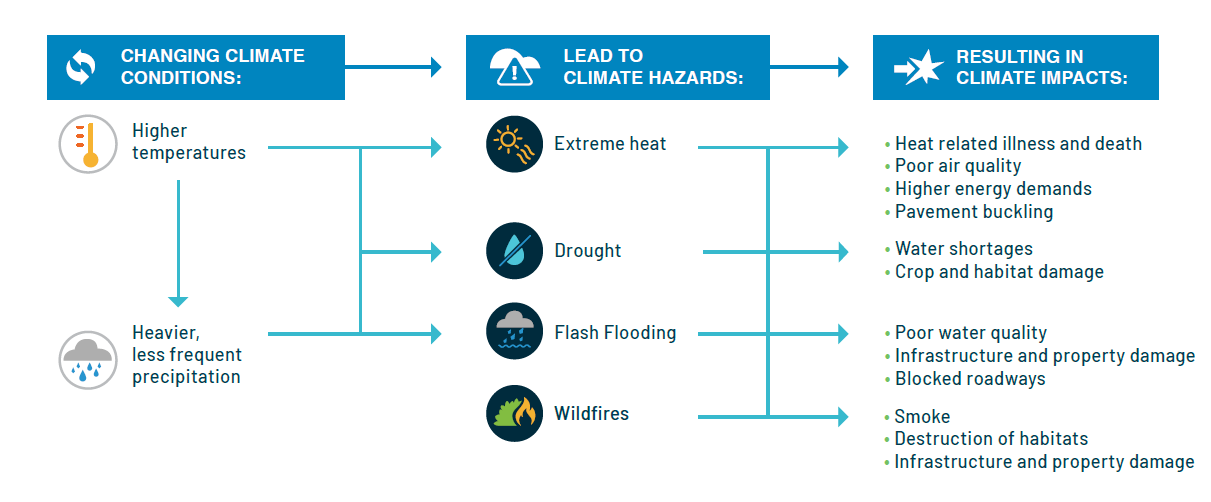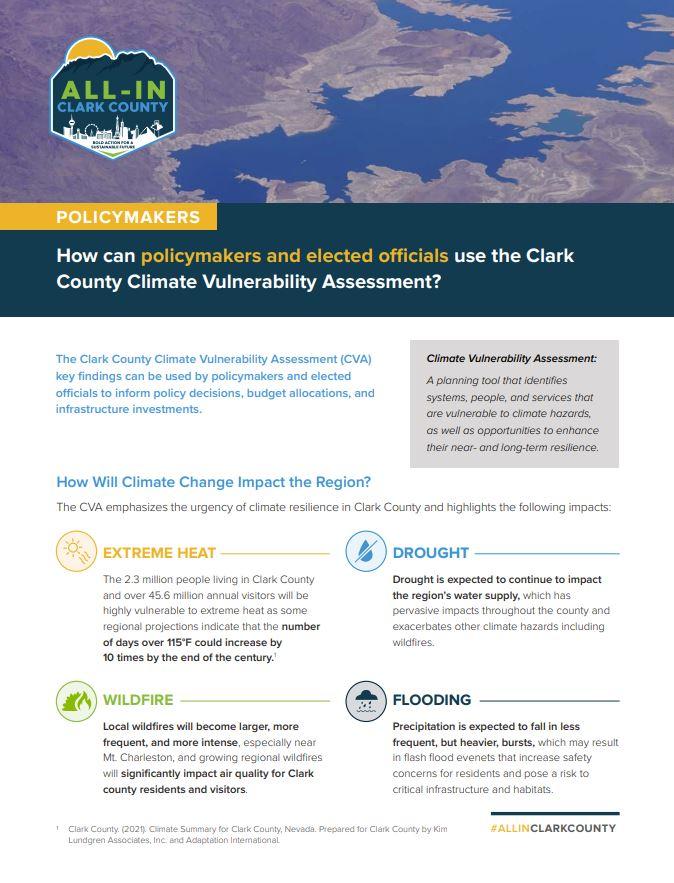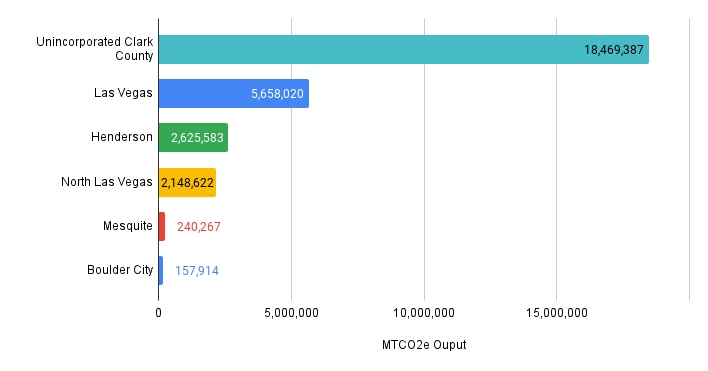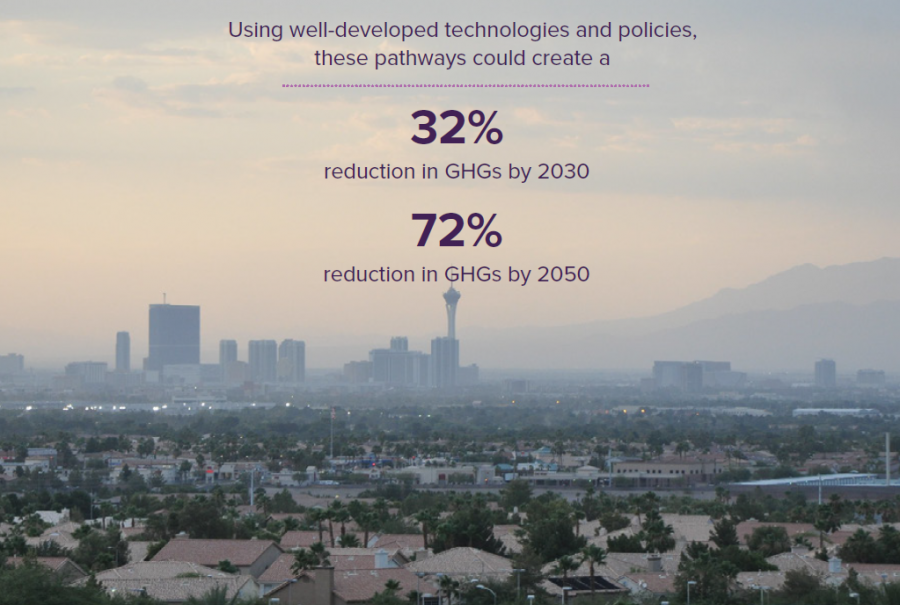Climate Change in Clark County
Jump to a spot on our page!What is Causing Climate Change?
Why is Our Climate Changing?
Science has shown that there is an indisputable link between human activity and the changes in the climate. When fossil fuels like coal, natural gas and gasoline are burned to power homes, businesses and vehicles—and when waste is buried in a landfill—greenhouse gas (GHG) emissions are released into the atmosphere.
These emissions —primarily carbon dioxide (CO2), methane (CH4), and nitrous oxide (N2O)—create a thick “blanket” in the atmosphere, trapping heat and leading to disruptions in the Earth’s climate. These disruptions lead to changes in temperature and precipitation, resulting in the extreme weather events already experienced around the globe and Southern Nevada.
How Climate Change Impacts Us

What Are the Hazards?
In Clark County, increasing GHG emissions yield two major changes in the climate: higher temperatures and more extreme (in both directions) precipitation events. Although Clark County experiences a variety of hazards (including extreme winds), there are four main hazards currently linked to climate change that are already affecting the County: extreme heat, wildfires, flash flooding, and drought. In turn, these hazards can negatively impact public health, infrastructure, and quality of life.
Climate change is a threat multiplier, which means that it will directly and indirectly impact people, infrastructure, natural systems, and the economy in important and compounding ways. As climate hazards increase in frequency and intensity, communities may have less time to recover between them. It is also more likely that multiple hazards will impact communities at once. For example, a wildfire during a drought would result in compounding risks to human health and safety.

Adapting to a New Reality
Identifying the systems in Clark County that could be most impacted by the worsening impacts of climate change is the first step towards addressing vulnerabilities. In 2022, the County developed a Climate Vulnerability Assessment (CVA) tool that identifies the highest priority climate actions that will reduce emissions and increase resilience for our communities.
What Can We Do About Climate Change?
Assessing Our Contribution
In 2019, across all sectors, the Southern Nevada region was responsible for 30 million metric tons of carbon dioxide equivalent (MTCO2e). This is approximately the same amount of GHG emissions as burning a train-load of coal stretching from Las Vegas to Cleveland, Ohio! The key to preventing the worst scenario of project climate impacts is to reduce the amount of GHG emissions we generate.
Our biggest opportunities to reduce emissions are in the buildings and transportation sectors. Electricity used in buildings was responsible for the largest share of GHGs (33.2%) and on-road transportation, which includes both passenger vehicles and trucks, was the second largest share at 22.7%. Learn more about what drives emissions in the Regional Community Greenhouse Gas Emissions Report.


Emissions Across the County
Clark County contains diverse jurisdictions, from rural to urban and everything in between. Each community has its own unique operations, geographies, and populations, and the amount of emissions produced tends to be affected by community size. For example, Las Vegas is home to 29% of the population of Clark County and accounts for 24% of Clark County's GHG emissions.
Unincorporated towns contributed 18,469,387 MTCO2e and represented the largest share of regional emissions (55%). This includes municipalities such as Enterprise, Paradise, Moapa, and Sunrise. Rural activities such as off-road transportation and agriculture, forestry, and other land use were included in this category.
We're All-In On Solutions
Clark County has created "pathways" to achieve bold emissions reductions both within local government operations and in the broader community. Through two planning processes and related assessments and analysis, the County conducted a GHG Pathways Analysis to identify a portfolio of strategies that are most likely to reduce emissions to near zero by 2050. Both the All-In Community Plan and the All-In County Operations Plan focus on emissions reduction targets in the short-term, between now and 2030, to ensure that we stay on track to achieve our 2050 targets in the long-term.
